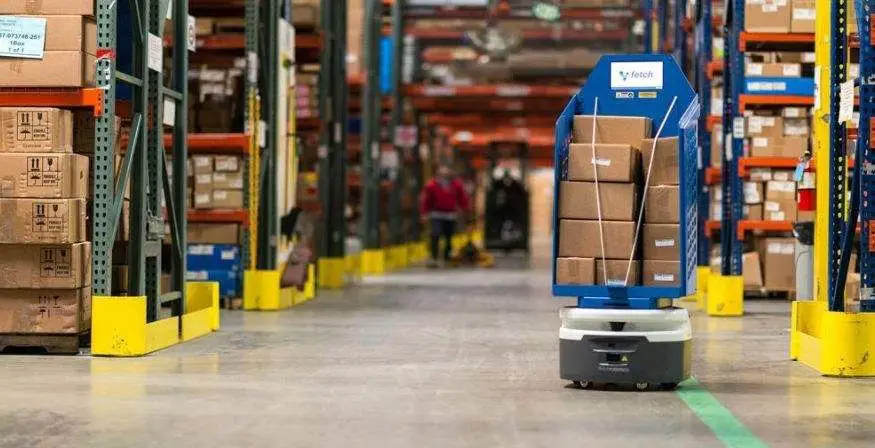Using AGV Warehouse Automation to Increase Your Productivity
Forklifts are approaching their final days as industrial leaders are noticing the benefits of AGV warehouse automation. AGVs, IGVs, and RGVs are the best way to speed up the transportation of material and items across your facility. However, if you want to implement the best one for your operation, it is critical to know their differences, pros, and cons.
What are IGV, RGV, and AGV Warehouse Automation?
As a central element of warehouse automation, mobile transport robots have seen explosive popularity recently. Automated, intelligent, and rail-guided vehicles are used to expedite material handling and transfer by incorporating different degrees of automation and intelligence into your operation. They can be utilized in production, distribution, and warehouse centers to minimize the manual movements of items. Therefore, using a smart vehicle system in your warehouse will significantly speed up your order fulfillment process, saving you time and labor costs.
The Key Differences Between Warehouse AGV, IVG, and RGV
When people think of guided vehicles, they usually only know about automated guided vehicles. However, two other types of them have a unique set of benefits and applications. AGV, IGV, and RVG each have their respective roles in the automated warehouse logistics system, but to choose the best one for your facility, you must understand how they work and their pros and cons.
1. AGV (automated guided vehicle)
An automated guided vehicle is a robotic machine that follows software and sensor-based guidance systems such as marked lines, wires, radio waves, magnets, cameras, or lasers to navigate the workplace. The sensor-based system enables AGVs to move on a predictable path and detect any people or obstacles in the way, providing a safe method of transportation. Therefore, using AGV Warehouse Automation allows you to transport heavy materials around your facility more efficiently and safely. AGV for warehouse facilities is usually used to transport raw materials and finished items to production lines and storage or retrieval, supplementing your picking and distribution processes.
Advantages of AGV Warehouse System
Reduce labor requirements by eliminating the need to hire workers for repetitive tasks.
Limit product damage by replacing traditional forklifts that are prone to accidents.
Improve fulfillment speed and accuracy by automating product movement.
Increase warehouse safety by getting rid of manual forklifts that are likely to cause injury.
Enhance flexibility by allowing systematic interfaces that have various stands, automation, and manufacturing options.
Disadvantages of AGV Warehouse System
Potentially high start-up costs.
Routine maintenance and repair costs.
Limited to repetitive tasks.
2. IGV (intelligent guided vehicle)
Intelligent guided vehicles are a new concept, only being used in facilities in recent years. Compared to AGV warehouse automation, IGVs offer more flexibility as they do not need fixed markers to travel across a workplace. IGVs run strictly on a digital software system, rather than a combination of computerized and physical guidance, meaning they can be changed and scheduled per your production needs.
Advantages of IGV
Installation only takes a few hours.
Increased flexibility, meaning that it can be reconfigured according to production needs.
The capacity of up to 3,300 pounds.
Do not require fixed markers to travel.
Disadvantages of IGV
More expensive to implement than AGVs.
Not widely available yet compared to other automation solutions.
It may be challenging to learn the software that IGVs require to operate.
Increased downtime due to maintenance and software updates.
3. RGV (rail-guided vehicle)
RGV systems consist of a series of rails that robotic vehicles travel on to transport goods across a facility. These vehicles make it easy to transport larger quantities and heavier items across your warehouse efficiently and at a low cost. Because rail-guided vehicles are so reliable, they are implemented into a variety of industries. These vehicles have been around longer than their counterparts and are a less expensive investment meaning that many warehouses rely on them for their daily operations.
Advantages of RGV
Easy to install into your facility.
Highly scalable, meaning it can be customized to fit most operations.
Vehicles can easily be removed and replaced without halting the entire system.
Less expensive implementation compared to IGV and AGV warehouse systems.
Disadvantages of RGV
RGV technology is somewhat dated compared to the other solutions with increased automation.
Rails are difficult to change and move, limiting flexibility.
RGV systems require ample space for their tracks.
The Future is Heading Towards Full AGV Warehouse Automation
AGV warehouse systems are the future of industrial automated solutions. These computerized vehicles offer significant benefits with few downfalls, making them perfect for almost any company. Additionally, they can be used with IGVs and RGVs, depending on the space and materials you want to transport. Therefore, it is worth it to consider integrating multiple automated transportation options to maximize your warehouse efficiency.
Why You Need Automated Vehicles in Your Warehouse
Although the steep start-up costs of AGVs and other vehicles often deter businesses, your initial investment will quickly be recovered from reduced labor costs, increased productivity, limited mistakes, and less machine maintenance. Plus, you will continue to grow your profit margin the longer you use these systems in your facility as they will optimize your workflow, allowing you to fulfill orders faster than before. So, if you want to improve your operation and earn more money, it is essential to implement an automated vehicle that will decrease your production time.

